TOOLS OF THE TRADE
Josh Zeman talks to 14 cinematographers, gaffers and grips about their favorite new gadgets.
Every year equipment manufacturers come out with loads of enticing new gear, but the true mark of any particular item’s usefulness is the extent to which it’s adopted by working crew members. We asked a dozen grips, gaffers and d.p.’s to tell us what’s in their kit, their equipment package, or simply their film wish list.
ROB BAROCCI, d.p.
On the One, Club Dread (second unit), Super Troopers (second unit)
There’s this really interesting new piece of grip equipment that I like to use whenever I’m in Miami. It’s a homegrown, custom item developed by a guy named Evan Nelson called an e-slide, and it’s a metal sliding base for a camera. It can be mounted on a dolly or on a crane/jib arm (it has a sliding Mitchell plate adapter on linear bearings), or it can be used freestanding. You can rest it on two stacks of apple boxes. Depending on the position of the base, you can get lateral or horizontal camera movement just like a dolly on a track. But because you don’t have to lay track, it’s really quick and adjustable, which is great when there aren’t that many hands on your crew or you don’t have the time to move the track all over the place. It comes in lengths of two foot, four foot and six foot. If you’re in a tight hallway and you have to move over a railing it works great. If you’re pushing over a table, the camera can get right over it. When you have to hold on to an over-the-shoulder shot, the operator can just make the adjustment rather than the dolly grip. And with the six-foot sliding base, you get more travel than you would with an eight-foot piece of track because there’s no dolly in the way taking up four feet. It’s a really quick way to get six feet of travel.
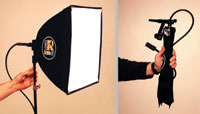 |
| Lowel's Rifa-lite 44 collapsible softlight. |
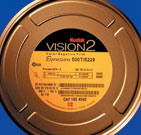 |
| Kodak's Vision2 500T film stock. |
MICHAEL BARROW, d.p.
Human Error
I’ve been using the Kamio Ring Light from Kino Flo. It’s a matte box and ring light combined and it runs off of a battery or a.c. Any kind of ring light is customarily a “beauty light,” and this one is built directly into the matte box and is one of the most versatile that I’ve seen. Something we make at Xeno Lights is our own version of a Triffid, which is a frame that fits on a nook light, and it makes your conventional nook light into a very small soft light.
HARLAN BOSMAJIAN, d.p.
Lovely & Amazing, Saving Face
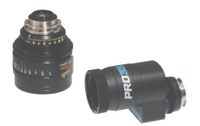 |
| P&S Technik's PRO35 lens converter. |
JIM DENAULT, d.p.
Heights, Maria Full of Grace
For me the biggest revelation recently has been DVD dailies. Now we’re not watching dailies on VHS in an old motel room anymore. Originally, if you wanted something that was at least okay it was Betacam. But now with DVD, the resolution is about comparable with Betacam dailies, although the color is still more compressed. Another cool dailies format is the DVHS, the JVC hi-def video system that works on VHS-D tapes.
Arri is coming out with a single-chip HD video camera that is going to make hi-def competitive with film. They are taking a 35mm camera and putting a chip where the film would be, meaning that the light hits the chip instead of film, but the viewing system still involves a ground glass and a lens. And the chip is the size of a 35mm frame — the depth of field is the same. And since it has a single chip, all those back-focus problem are solved. All the hi-def cameras now are just video news cameras that are made to record hi-def. The way these video-camera operators work is completely different than a film d.p. But when this thing comes out, it will make hi-def a viable medium for film production.
STEVE GAINER, d.p.
Black Cloud, A Dirty Shame, Bully
Probably the coolest piece of equipment I’ve worked with in the past year is the XR gyrostabilized head from Wescam. When I was shooting Black Cloud in Monument Valley for director Rick Schroder, the script called for tracking shots of our hero riding bareback across this rugged terrain. I could have used a Steadicam mounted on a truck, but then I would have been limited to one height. By mounting the XR on a 17-foot jib arm, I was able to not only change the height of the camera but also the angle I was shooting from, allowing for some really stunning moments. Our time was limited due to a dust storm earlier in the day, so I had just three hours to get all the riding shots for the movie. The Wescam crew was fantastic! Justin Webber and Steve Hertler had the rig up and running in minutes. I can’t wait to work with it again.
BEN GAMBLE, gaffer
A Dirty Shame, Mysterious Skin
 |
| Kino Flo's ParaBeam lights. |
DAVID GRIFFITH, Hand Held Films camera rental house
Cine Magic in Manhattan makes an accessory called the Snapshot, which is a Mamiya 645 medium-format camera with a viewfinder hood that mounts onto the lens of a 16mm or 35mm motion picture camera. With the Snapshot you can simulate in-camera the photographer’s process of taking a picture. This used to be achieved by shooting with a normal motion picture camera and then putting a matte over the image in post. Now you can go through focus, see the actual ground glass as well as the focusing center, and record the shutter moving in and out of the frame.
ALAN JACOBSEN, d.p.
Wet Dreams and False Images (doc), Room Raiders (TV), Eating the Scorpion (doc)
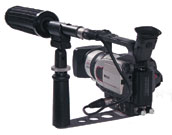 |
| Videosmith's Mini Rover camera handle. |
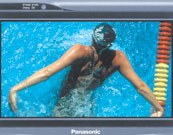 |
| Panasonic's TC-7WMS1 7" LCD monitor. |
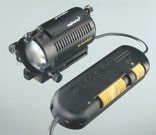 |
| Dedo's DLH4 dual-lens light. |
MICHAEL MAYERS, d.p.
Bounty Hunter (TV pilot), The Lyon’s Den (TV series), The Education of Max Bickford(TV Series)
Lately I’ve been using a lot of those lightweight zooms that cover 17.5mm to 200mm. Both Panavision and Clairmont in L.A. have them. Panavision has a 17.5/34mm T2.8 Canon, a 27/68mm T2.8 Canon and an 85/200mm T4 Leica. Clairmont has a 17/35mm T3 Century and a 28/70mm T3 Century. They’re rehoused still lenses, and for TV they are just great. They’re not as sharp as the Primo zooms or the Cookes, but they’re plenty sharp and very versatile, especially when handholding or doing Steadicam. They’re lightweight, and the focal lengths break in better places than the Arri zoom lenses.
On the show I’m on now, we’re using a lot of Mole beam projectors. They give you the effect of a Xenon projector, and they are very spotty. If I want a shaft of light going through a window, it’s a great lightweight unit, much quieter than the Xenons. While the prices may be comparable to a Xenon, they come in both tungstens and HMIs, while the Xenon only comes in… Xenon. They have a great range, too. On the HMI the wattage range is from 1,200 up to 12K, and on the tungsten side the wattage ranges from 2K up to 20K. And you can actually dim the tungstens, which is nice. Also you can hang the units straight down, which you can’t really do with a Xenon.
 |
| Cartoni's Lambda tripod head. |
MICHAEL OTAÑO, d.p./camera operator
Corn(d.p.), A Perfect Murder (a.c.)
I’ve been using the P+S Technik 35mm adapter that allows you to use 35mm lenses with the AG-DVX100, PD-150 and many other digital video cameras. I’ve been using it with the DVX mostly, and I’m just floored with the results. Now I have the full spectrum of creative tools that I’m used to when shooting film. It makes the video camera a truly cinematic tool at low cost. With regards to the actual technology, the adapter incorporates an oscillating ground glass, which I think was originally designed as a director’s video viewfinder. P+S saw the potential and redesigned it for the new application that we see here. The first generation had a rotating ground glass, which was problematic, but the redesigned version with the oscillating ground glass is much better defined. It gives the video image a grainy quality yet without looking cheesy. It doesn’t look like an effect; it’s real and organic, and for me that’s the difference.
SCOTT RAMSEY, gaffer
The Manchurian Candidate, The Sixth Sense, Signs
On The Manchurian Candidate, we used a new light from Morpheus, the Panabeam XR2. It’s an automated 1200 watt wash light which was very versatile and much more powerful than the traditional automated lights. Something else I’m very excited about is the LED light panel from Lite Panels. It’s also extremely versatile, and it’s easy to hide and generates no heat. It has gel packs that take it from daylight to 3200. The kit comes with two units, and each unit has a battery that lasts up to two hours. And it can also run off a 12-volt car battery or be plugged into the wall. It’s ideal for car rigs, it’s a great little eye light, and it will be perfect for use with ENG cameras.
STEVE Ramsey, gaffer
Door on the Floor, American Splendor
J.L. Fisher has a new jib arm called the Model 23. If you need to get the camera high or get a wide range, the Fisher 23 has a long arm with a range of 6 to 21 feet. It attaches to the center mount of a Fisher 10. For swing shots you can use a manual operating system, but with the higher shots you’ll obviously need a remote head. It’s a very nice piece of equipment, and the assembly is quick and easy. You need two people, but it takes only 10 to 15 minutes to assemble. While it’s not necessarily cheaper than a crane, there are some reasons to use this jib over a crane. Personally, I always prefer to use a remote hothead and a jib rather than a crane. I never like putting someone up in a bucket when you don’t have to, especially when that person is someone who is constantly needing to take light-meter readings. And you don’t have to have guys come in and build it, like a crane.
DAVE STERN, key grip
From Other Worlds, The Mudge Boy, Second Best, P.S.
 |
| J.L. Fisher's Soft Compound dolly wheels. |
Dolly wheels: We all know J.L. Fisher. Well, J.L. has a got a new set of wheels called soft compound dolly wheels, and they are amazing. If your dolly grip has any experience with dance floor work, these wheels can save a lot of time resetting track. They are the perfect mix of soft and hard to keep the camera steady but still go over minor bumps.
JASON VALEZ, key grip
Bought & Sold, Particles of Truth
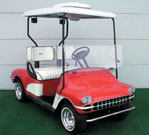 |
| Golf cart. |
VOD CALENDAR


 See the VOD Calendar →
See the VOD Calendar →


